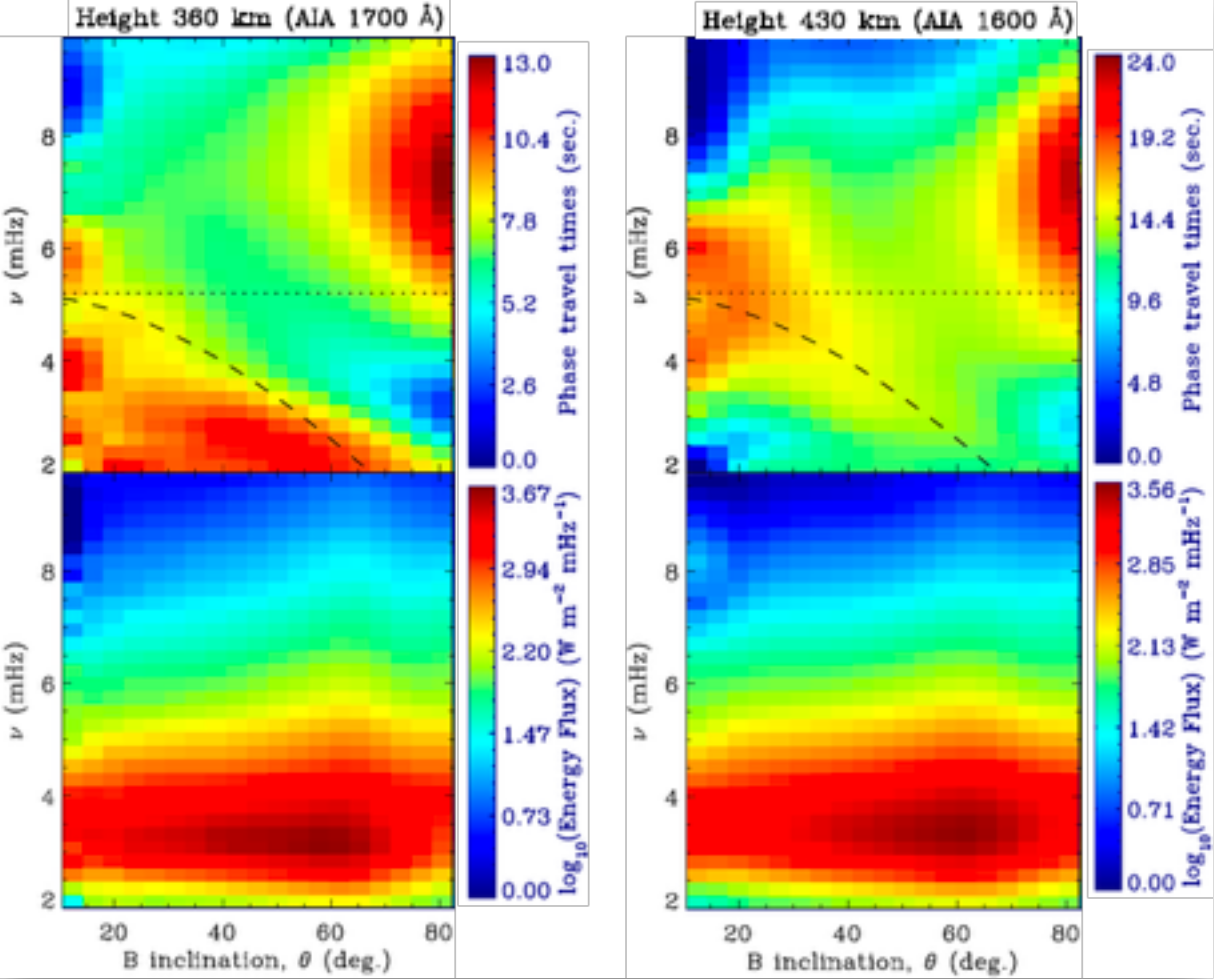S.P. Rajaguru1, C.R. Sangeetha2, and Durgesh Tripathi2
1. Indian Institute of Astrophysics, Bangalore-34, India
2. Inter-University Centre for Astronomy and Astrophysics, Post Bag-4, Ganeshkhind, Pune 411007, India
The Sun and sun-like stars require a constant source of basal flux of energy to heat their chromospheres and to balance the observed radiative losses. For the quiet Sun, the required energy flux is ~4.6 kW m-2 at the lower chromospheric heights. Charting out the sources of such energy supply is a long-standing problem in solar physics.
A favored mechanism has been the heating by acoustic waves that can propagate up, hence of frequencies larger than the photospheric acoustic cut-off ν of ~5.2 mHz. However, observational estimates backed by numerical simulations showed that such waves carry only about one-tenth of the required energy[1], raising the possibility that the photospherically anchored small-scale magnetic fields could play a dominant role. Since then, waves of different nature, viz. acoustic, magneto-acoustic, and Alfvén type, with periods in the 5 minute range corresponding to the Sun’s internal p modes, have been ubiquitously observed in the solar atmosphere. This has largely been attributed to inclined magnetic fields that can lower the cut-off frequency. In a study[2] published recently, however, we report the detection of a significant fraction of such waves originating in the nearly vertical magnetic field elements of the quiet-Sun defying the above explanations.
Figure 1| Maps of magnetic inclination angle θ (bottom panel), phase travel time, and logarithm of energy flux over the quiet-network area for acoustic waves of frequency 3 mHz propagating from 170 km (HMI line-core intensity Ico) to 360 km (AIA 1700Å).
Exploiting simultaneous photospheric vector magnetic field, Doppler, continuum, and line-core intensity (of FeI 6173Å) observations from SDO/HMI and lower-atmospheric UV emissions in the 1700Å and 1600Å channels of the SDO/AIA, we have studied in detail the relationships between magnetic inclination and strength and the acoustic wave propagation (phase travel time) over quiet, plage, and sunspot areas (see Ref. [2] for details). We show in Figure 1 the 3 mHz maps of phase travel-times and energy fluxes, along with that of magnetic inclination, θ, to the solar surface normal, over a quiet-Sun area. It is clear that the energy fluxes concentrate within the discrete magnetic field elements, confirming the presence of magneto-acoustic portals due to magnetic fields in the maps of Figure 2. The region of smaller θ and ν bounded by this curve in the θ-ν plane, in principle, is not accessible for wave-propagation via reduction in νac due to θ. However, strikingly, almost the whole of this region of low ν and θ<60° is filled with propagating waves in the case of lower height (360 km, 1700Å). Thus the relatively less-inclined, nearly vertical magnetic field elements in the quiet-Sun channel a significant amount of acoustic waves of frequencies, in the range of 2 - 4 mHz.
 Figure 2| Phase travel times and logarithm of energy fluxes against θ and wave frequency, ν, over the quiet-Sun regions; left panels are for AIA 1700Å height (360 km) and the right panels are for AIA 1600Å height (430 km). The dotted line in each panel is the cutoff frequency νac=5.2 mHz, and the dashed line is νac cosθ.
Figure 2| Phase travel times and logarithm of energy fluxes against θ and wave frequency, ν, over the quiet-Sun regions; left panels are for AIA 1700Å height (360 km) and the right panels are for AIA 1600Å height (430 km). The dotted line in each panel is the cutoff frequency νac=5.2 mHz, and the dashed line is νac cosθ.
The mean energy flux over the quiet-Sun (or quiet magnetic network), over the 2 – 5 mHz frequency region, between the upper photosphere and heights corresponding to AIA 1700Å and 1600Å intensities is in the range of 2.25 to 2.6 kW m-2 (Figure 3), which is about twice the previous estimates[3]. Out of this total quiet-Sun acoustic flux, about 25 to 30% is due to the above identified wave-propagation in the 2 – 4 mHz over the vertical magnetic fields.
Figure 3| Mean wave-energy fluxes against frequency at heights 360 km (AIA 1700~{\AA}). The three curves, black, red and pink correspond to mean fluxes over quiet-network, plage and spot areas, respectively. Frequency-integrated fluxes over 2 – 5.2 mHz and 5.2 – 10 mHz ranges are marked.
As discussed in detail in our paper[2], we find that the case of the tube mode (or sausage mode) subject to strong photospheric radiative damping, as theorized by Roberts[4], provides an interesting explanation for our results for quiet-Sun magnetic fields. An alternative possibility is the magneto-convective process[5] within flux tubes or sheaths that drive upward propagating longitudinal waves over a broad frequency range, 1 – 10 mHz, with peak power around 4 mHz, providing possible explanations for our observational results in Figures 2 for the quiet-network.
Please refer to Ref. [2] for details.
References
[1] Fossum, A., & Carlsson, M. 2005, Nature, 435, 919
[2] Rajaguru, S. P., Sangeetha, C. R., & Tripathi, D. 2019, ApJ, 871, 155
[3] Jefferies, S. M., McIntosh, S. W., Armstrong, J. D., et al. 2006, ApJL, 648, L151
[4] Roberts, B. 1983, Solar Phys, 87, 77
[5] Kato, Y., Steiner, O., Hansteen, V., et al. 2016, ApJ, 827, 7
